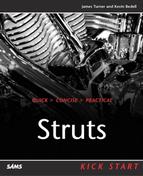Book Description
Learn to build applications with Jakarta Struts, the most popular JSP development framework. Struts Kick Start is a "hands-on" book filled with sample applications and code snippets you can reuse, and in-depth coverage of new features in Struts 1.1. If you are looking for a practical book that "shows you how to do it", then Struts Kick Start is for you. Plus, it's the first Struts book with detailed examples of the major Struts tags.
The book begins with a discussion of Struts and its Model-View-Controller (MVC) architecture. The authors' then demonstrate Struts' power through the development of a non-trivial sample application - covering all the Struts components in a "how to use them" approach. You'll also see the Struts Tag Library in action - use tags for HTML, javabeans, logical operations and more. You'll learn to use Struts with JBoss for EJB's, with Apache Axis to publish and use Web Services, and with JUnit for testing and debugging. The authors work with the latest Struts 1.1 features including DynaForms, Tiles and the Validator.
The book includes a CD-ROM containing the tools discussed in the book: Struts 1.1 beta 2, Java 2 Standard Edition, JBoss 3.0.3, MySQL 3.23, XDoclet, Torque, Tomcat, Ant, Axis, Cactus, and JUnit. Plus, it comes with an electronic, fully searchable version of the book.
From the Inside Cover: Thoroughly covers the essential features of Struts in a clear and readable style.
Struts Kick Start is a solid starting point for learning how to develop web applications using Struts. The authors start you off by reviewing the foundational technologies on which Struts is based, and immediately get into the sorts of practical "how to" information and examples that get you up to speed quickly.
Notable features that I really appreciated include the coverage on integration with other technologies (such as EJBs and web services), using Ant to set up your development environment, and the fact that the software goodies you need are available on the included CD. Struts does not live in a vacuum -- it is one of the tools in the developer's toolkit, so knowing how it works with other technologies is very useful.
Of particular importance is the coverage on testing your web application as you build and maintain it. Developing a solid testing methodology, and a substantial suite of tests (to protect yourself against regressions), is critically important to a rapid development cycle that still needs to produce high quality applications. Coverage of testing, though, tends to be minimal in many books about programming technologies. James and Kevin provide specific advice on how to use the JUnit and Cactus testing frameworks with your Struts based applications.
Struts Kick Start is a good resource for learning about Struts, and it will help you get up to speed quickly.
- Craig McClanahan, Creator of Struts
Table of Contents
- Copyright
- About the Authors
- Acknowledgments
- We Want to Hear from You!
- Introduction
- Struts in Context
- The Model-View-Controller Design Pattern: ’Model 2’ JSP Development
- Hello World!: A First Struts Application
- Hello World! Application Requirements
- Applying the Model-View-Controller Pattern
- The View Component: The HTML Form and the Form Bean
- MessageResources and Application.properties Files
- The Struts Form Bean: HelloForm.java
- Data Validation and ActionErrors
- The Controller Component: HelloAction.java
- The Model Component (HelloModel.java)
- Passing Data to the View Using Attributes: Constants.java
- Tying It All Together: The struts-config.xml File
- Conclusions
- HTTP Protocol: Web Application Communications and Control
- JSP, Taglibs, and JSTL: Extending Java onto the Page
- The Sample Application: A Financial Portfolio
- View Components: What the End User Sees
- The Controller: Directing the Action
- Model Components: Modeling the Business
- The struts-config.xml File: Tying All the Pieces Together
- How the Struts Tag Libraries Work: The View from Inside
- Struts HTML Tags: Page Construction and Form Processing
- Struts Tags, JSP Custom Tags, and Java Scriptlets: What’s the Right Balance?
- Using Struts HTML Tags to Render Basic HTML Elements
- The Basics of Form Processing
- Check Boxes and Radio Buttons
- Drop Downs and Select/Option Lists
- Input Validation and <html:errors>
- Uploading a File Using <html:file>
- Conclusions
- Struts Bean Tags: Storing and Passing Data
- Struts Logic Tags: Conditional Presentation Logic
- The Nested and Template Struts Tag Libraries: Handling Subproperties and Inserting Content
- The Struts Tiles Tag Library: Creation Master Document Templates
- DynaForms and the Validator
- Using Struts with Enterprise JavaBeans
- Using Struts with Web Services
- Building, Deploying, and Testing Struts Applications
- An Integrated and Incremental Build/Test Cycle: It’s Extreme!
- Building and Deploying Struts Applications Using Jakarta Ant
- Developing a build.xml File for Building Struts Applications Using Ant
- Extreme Struts Development with Integrated and Ongoing Testing
- Mock Object Testing Using JUnit, StrutsTestCase, and Ant
- In-Container Testing Using Cactus, JUnit, StrutsTestCase, and Ant
- Conclusions
- Installing Struts and the Sample Applications from the CD
- Index
